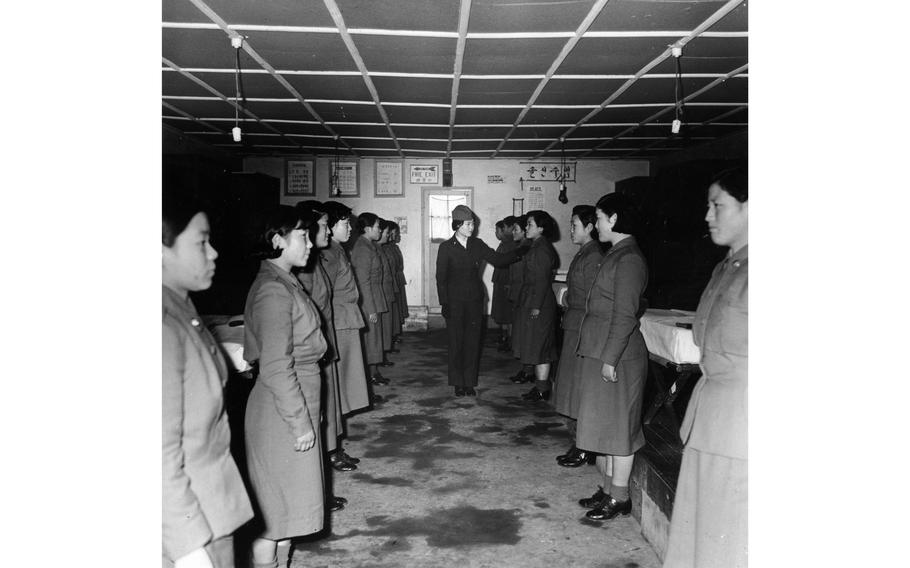
1st Lt. Seuk Yun Yoo, commander of the 1st Company conducts a barracks inspection of the WAC recruits’ quarters. (Kim Ki Sam/Stars and Stripes)
This article first appeared in the Stars and Stripes Pacific edition, Feb. 28, 1960. It is republished unedited in its original form.
In the dark days of fall 1950, a handful of Republic of Korea civilian and military leaders met in Pusan to discuss measures to stem the tide of the north Korean communist hordes posed in an offensive arc along the famous Pusan perimeter.
It was from this meeting that the first ROK Women’s Army Corps was formed. These Wacs, then a small but rugged group of women fighters, provided a boost to the psychological warfare activities of the United Nations Command.
During the Korean War many of the Wacs, standing in bunkers on the mortar-pocked hillsides and the near front-line artillery emplacements, broadcast personal appeals and propaganda material to the communists using giant field loudspeaker systems.
“Several times artillery and mortar fire landed so close to me that I couldn’t hear myself speaking,” Maj. Hi Yui Yoon, an announcer with the early contingent of Wacs said. She is now the training director of the ROK WAC Training Center located near the Seoul Area Command.
“One time in central Korea, I was broadcasting from a hillside. The communists were moving in assault position and the air was filled with the sounds of exploding shells.
“I kept on speaking, telling them to give up, lay down their arms, not to continue killing their brothers in arms. Later in the afternoon the attack was repulsed.”
During that specific incident two of the Wacs were killed. Three are still carried on the rosters as missing in action.
Today, marching side by side with their male counterparts, are some 1,000 WAC officers and enlisted men, under Lt. Col. Seung Won Hyun, ROK WAC commandant.
Generally the Korean Wacs share the same spartan training, food and pay as the male ROK soldier, although some of the men are quick to point out that “they get a few little extras like softer mattresses and more hangers for their clothes.”
Basic training for the women, given at the Seoul Training Center, is roughly the same as the training undergone by ROK soldiers at Nonsan. Included are courses in first aid, weapons training, squad drill, map reading and typing.
Administrative skills, particularly those of the clerk-typost, are stressed because this is the type of work in which most of the graduates will be placed.
“We like to teach our women how to shoot, how to work in an office and how to behave like soldiers,” Col. Hyun explained. “But we also like them to retain as many feminine graces as possible.”
The Wacs are allowed to use a little lipstick, “but not too much.” They are also required to keep their hair neat and closely trimmed, which is usually done in a fully-equipped beauty shop in the training center.
Like the regular soldier, the Wacs must also have passes to leave the compound. They must get up early in the morning, must keep their barracks area neat, their uniforms clean and their weapons spotless.
Enlisted Wacs live at the training center and at several other ROK Army compounds scattered throughout the Korean peninsula. All their barracks are carefully groomed and, except for an occasional mirror or long-handled comb, differ little in appearance from an ordinary ROK soldier’s quarters.
Many of the WAC officers live in off-post dwellings.
The command hierarchy of the Wacs is also patterned after that of the ROK Army — Col. Hyun as commandant; Maj. Duck Soon Kim in charge of administration; Maj. Yoon, training; Maj. Ka Yung Lee, director of subject courses, and Capt. Chin Hack Park, administration and subject courses.
A host of young and alert lieutenants handles such assignments as intelligence, public information, troop information and education as well as the lower troop commands.
During the Korean war, the Wacs near the frontlines carried rifles and grenades and according to the stories told of their exploits, they often had to use their weapons.
“I felt like shooting many times,” Maj. Yoon said, “but I always clung to my microphone and kept on talking.”
“Perhaps my words were as good as bullets. Never once did I have to run.”
Looking for Stars and Stripes’ historic coverage? Subscribe to Stars and Stripes’ historic newspaper archive! We have digitized our 1948-1999 European and Pacific editions, as well as several of our WWII editions and made them available online through https://starsandstripes.newspaperarchive.com/